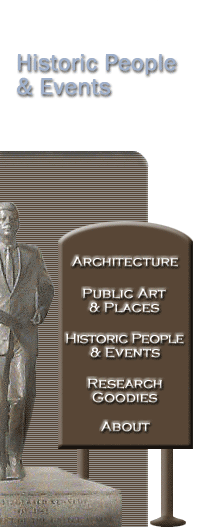|
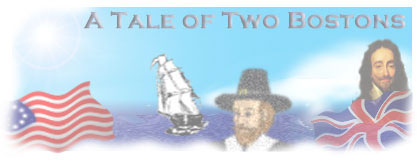  eligion.
Politics. Rebellion. Boston’s pedigree was forged back in England in the
midst of religious dissension, where Puritans and Pilgrims sought religious
reform, and Cavaliers and Roundheads vied for political power. The question
isn't where did Boston get its name – but how. eligion.
Politics. Rebellion. Boston’s pedigree was forged back in England in the
midst of religious dissension, where Puritans and Pilgrims sought religious
reform, and Cavaliers and Roundheads vied for political power. The question
isn't where did Boston get its name – but how.
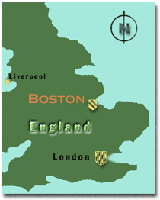 The
Short Answer The
Short Answer
Like a great many towns in New England, Boston has its naming roots in old
England. Boston, Massachusetts is named after Boston, Lincolnshire, and
is situated about 100 miles north of London on the North Atlantic Sea.
Massachusetts began life as the Massachusetts Bay Colony (Company) in 1629.
Its first Governor was John Winthrop,
and its first deputy-Governor was Thomas Dudley, who shortly after their
arrival in America in 1630 suggested that the capital of the colony be named
after their hometown back in England. Both men were part of a fleet of Puritans
- about 1000 - that came over to escape religious and political persecution
for their desires to reform the Church and State. Though how and why this
all occurred is far more interesting and ironic once you know the historical
context of the times. So, all aboard the Puritan Express...
The First Boston
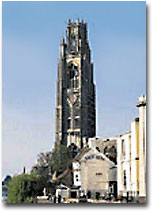 |
St. Botolph's
Church
A Gothic
stump from 1309
|
 Five
years after the Battle of Hastings (1066) where William the Conqueror
subjugated much of England, a parcel of land in Lincolnshire was gifted
to one of his noble supporters from Brittany. A church was built – often
the precursor to what we would call “development” today. It was named
after an orthodox saint with the unorthodox name “Botolph” that preached
throughout England in the 7th century. Saint Botolph (ca 610
- 680) began his religious training as a monk in Gaul (modern day France).
In 654, he returned to England and founded the monastery of Ikanhoe in
East Anglia. No, not Ivanhoe - that's a novel by Sir Walter Scott.
Coincidence? I think so. Five
years after the Battle of Hastings (1066) where William the Conqueror
subjugated much of England, a parcel of land in Lincolnshire was gifted
to one of his noble supporters from Brittany. A church was built – often
the precursor to what we would call “development” today. It was named
after an orthodox saint with the unorthodox name “Botolph” that preached
throughout England in the 7th century. Saint Botolph (ca 610
- 680) began his religious training as a monk in Gaul (modern day France).
In 654, he returned to England and founded the monastery of Ikanhoe in
East Anglia. No, not Ivanhoe - that's a novel by Sir Walter Scott.
Coincidence? I think so.
Tradition has it that
the place came to be called "Botolphston" – either from "Botolph's
stone" or "Botolph's town" – which was later contracted
to "Boston." Remember, these were the same wily bunch of seafaring
people who gave us the terms fo'c'sle (foke-sol) for "forward
castle" and bo's'n (bo-sun) for "boatswain." With
that in mind, I can believe "Boston." Or is it B'st'n?
 Unlike
tradition, however, evidence suggests that Boston was not the site of
St.Botolph's monastery. It is more likely that Boston started in the 10th
century as a small Saxon village around a wooden church. The existence
of this church was recorded in the Domesday Book in 1086. As seen in the
photo, the church, known as "the stump," has improved considerably
from its humble wooden beginnings, though now suffers from a really bad
nickname. Unlike
tradition, however, evidence suggests that Boston was not the site of
St.Botolph's monastery. It is more likely that Boston started in the 10th
century as a small Saxon village around a wooden church. The existence
of this church was recorded in the Domesday Book in 1086. As seen in the
photo, the church, known as "the stump," has improved considerably
from its humble wooden beginnings, though now suffers from a really bad
nickname.
|
|
|
A
Lord-Mayor in fashionable
formal wear.
|
During the Middle
Ages, the village grew to become the second most important port in England,
enjoying great traffic from Hanseatic traders of northern Europe. In 1545,
the town was granted it's charter, which allowed the Lord-Mayor to dress-up
in elaborate robes, wear a large black velvet three-corner hat, and sport
the town seal suspended from a large gold chain. By the 17th century,
Boston had become a hotbed of religious nonconformism, inspired by figures
such as John Foxe and John Cotton.
Many Bostonians, including Cotton, relocated to Massachusetts. In fact,
about 250 people left Boston, which was about a tenth of the town’s population,
to find new homes in Massachusetts over the next few years. Furthermore,
throughout the emigration period of 1620-1640, England lost over 20,000
people to Massachusetts.
But why? Why did so
many people want to leave England? Didn't they know about Massachusetts'
winters?
Nonconformists: Reforming
the Church and State
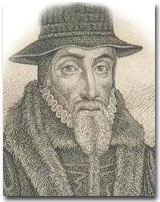 |
|
John
Foxe
|
 In
October of 1517, Martin Luther nailed his 95 theological theses (declarations)
to the castle door in Wittenberg, Germany. Hoping to spark a little earnest
discussion, Luther got a revolution instead, or more accurately, a Reformation.
That same year, John
Foxe was born. Who, you say? Well if you were an ardent reader back
in 1563, or knew someone who was, you would know that John Foxe published
his work called “The Book of Martyrs.” It was a smash hit among those
in England dissatisfied with the Church, known as nonconformists,
of which there were a considerable amount. Many had been waiting since
Henry VIII for a real opportunity to reform the Church. Ah, that “great
reformer” of the Church, Henry VIII. Well, he wasn't really a reformer;
more of a hijacker. In
October of 1517, Martin Luther nailed his 95 theological theses (declarations)
to the castle door in Wittenberg, Germany. Hoping to spark a little earnest
discussion, Luther got a revolution instead, or more accurately, a Reformation.
That same year, John
Foxe was born. Who, you say? Well if you were an ardent reader back
in 1563, or knew someone who was, you would know that John Foxe published
his work called “The Book of Martyrs.” It was a smash hit among those
in England dissatisfied with the Church, known as nonconformists,
of which there were a considerable amount. Many had been waiting since
Henry VIII for a real opportunity to reform the Church. Ah, that “great
reformer” of the Church, Henry VIII. Well, he wasn't really a reformer;
more of a hijacker.
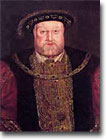 |
|
King
Henry VIII
|
 You
may remember that Henry VIII, a Tudor, was experiencing problems with
his marriage, as well as political difficulties, such that in 1533, he
convinced the Bishopric of Canterbury to annul his marriage to You
may remember that Henry VIII, a Tudor, was experiencing problems with
his marriage, as well as political difficulties, such that in 1533, he
convinced the Bishopric of Canterbury to annul his marriage to  Catherine
of Aragon. Not satisfied with his quick, Las Vegas-like annulment, Henry
saw this as an opportunity to get rid of his biggest competitor to wealth
and land – the Church. A year later, Henry had Parliament make him the
“Supreme Head of the Church in England.” This immediately severed all
ties with the Roman Catholic Church, and made him the ultimate power in
England. Think of it as a hostile take-over with Henry as the new CEO.
The Church and the State were now one. This was very good news to the
reformers, for they wanted to overhaul both institutions to make them
more biblically-based. This just made their task that much easier. The
reformers wanted all the folderol removed from the Church that they believed
was unnecessary, like ornate ceremonies, opulent vestments, and the ever-popular
Indulgence of the Month Club. Similarly, the State could work best
if it used the Bible as a template for such things as justice, so the
reasoning went. Catherine
of Aragon. Not satisfied with his quick, Las Vegas-like annulment, Henry
saw this as an opportunity to get rid of his biggest competitor to wealth
and land – the Church. A year later, Henry had Parliament make him the
“Supreme Head of the Church in England.” This immediately severed all
ties with the Roman Catholic Church, and made him the ultimate power in
England. Think of it as a hostile take-over with Henry as the new CEO.
The Church and the State were now one. This was very good news to the
reformers, for they wanted to overhaul both institutions to make them
more biblically-based. This just made their task that much easier. The
reformers wanted all the folderol removed from the Church that they believed
was unnecessary, like ornate ceremonies, opulent vestments, and the ever-popular
Indulgence of the Month Club. Similarly, the State could work best
if it used the Bible as a template for such things as justice, so the
reasoning went.
During all this “reformation,”
regular and somewhat subversive theological meetings were being held in
the White Horse Tavern in Cambridge, England. All good revolutions
seem to begin in bars. Among those present over the years were Thomas
Bilney, Hugh Latimer, Nicholas Ridley, and Thomas Cranmer – all of which
were later martyred for their beliefs. A rather sobering thought.
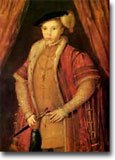 |
|
King
Edward VI
|
Henry had no particular
desire to "reform" the theology of the church, since it would
now more or
less serve him. However, there were many reform-minded people that did
care - particularly those frequenting the White Horse Tavern for Theological
Thursdays. Unfortunately for them, such desires found little royal
support during Henry's reign. After the King died in 1547, his nine-year-old
son Edward assumed the throne. Children would often rule through officials
called regents, much like agents chaperoning rock-stars today,
although with considerably less mess. The two regents that aided Edward
were the Duke of Somerset and the Duke of Northumberland, both of which
had some degree of sympathy for the reform movement's vision. The rush
was on for the “purification of the church and the state” between 1547
and Edward's death in 1553.
Mary: Olde England
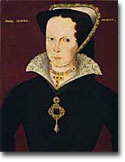 |
Queen Mary
I
"Bloody Mary"
|
The next Tudor on
the throne was Mary I Tudor, better known as "Bloody Mary."
Mary wanted nothing more than to turn back the clock and return England
to the Roman Catholic fold, no matter what the cost. So she pulled a Crazy-Ivan,
doing an about-face, and set the ship of State careening back towards
Catholicism. The result was a massive emigration of Protestant exiles
to Europe, settling into pockets in Geneva and Frankfort. With them went
John Foxe, who would continue to drink deeply of the dreams of Church
reformation, presumably at the White Horse Tavern's counterpart somewhere
in Switzerland or Germany.
Then, in 1558, good
news for the reformists: Mary I died, and her Protestant sister Elizabeth
reversed the earlier tide towards Catholic reunification, sending the
émigrés back home in droves. Crazy-Ivan number two. From the pen
of John Foxe, the reformers would demand the pure practice of both the
Monarchy and the ecclesiastical leaders, directing all English affairs
sola Scriptura – according to the Scriptures alone. Well,
with such momentum, what could possibly stand in their way?
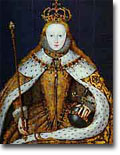 |
|
Queen
Elizabeth I
|
The next Queen of
England. Just when they saw light at the end of the tunnel, Queen Elizabeth
I surprised them. Elizabeth I’s desire was for political stability and
order, not extremism – especially the kind which the theological heirs
of those White Horse participants seemed to be. The State and the Church
should, in her view, be broad and inclusive and should base its life on
tradition and reason as well as on the teachings of Scripture. As a consequence
of her moderate approach, the word "Puritan" as
it's associated with the nonconformists became a name of ridicule during
the reign of Elizabeth I.
 By
1570, the nonconformists had split into two factions: those that wanted
to work within the system, and those that had had enough of it and wanted
to leave. And so they did, eventually. Elizabeth I died in 1603, and was
replaced by James I, first from the Stuart line. The Stuart line originated
from Scotland, and being from the north, they were natural allies to the
Cavaliers - the supporters of the Monarchy, associated with
the Nobility, peasantry, and Episcopalians. By
1570, the nonconformists had split into two factions: those that wanted
to work within the system, and those that had had enough of it and wanted
to leave. And so they did, eventually. Elizabeth I died in 1603, and was
replaced by James I, first from the Stuart line. The Stuart line originated
from Scotland, and being from the north, they were natural allies to the
Cavaliers - the supporters of the Monarchy, associated with
the Nobility, peasantry, and Episcopalians.
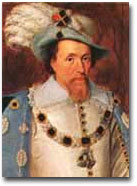 |
|
James
I
|
James enjoyed the
Monarchical power, the extravagant spending, and the belief in the divine-right
of kingship. James didn't like Parliament, Sir Walter Raleigh, or Puritans.
Over time, his relationship with Parliament eroded to the point where
they simply wouldn't give him anymore money. He had bungled foreign policy,
inflation was everywhere, and gave out peerages like cocktail napkins.
Politics spilt over into religion, and once again the ship of State made
a U-turn back to Roman Catholicism. Crazy-Ivan number three.
Though many considered
him a bit of a paranoid twit, he did manage to commission an Authorized
Version of the Bible, printed in English in 1611. In one of those
many ironic twists of history, an English Bible was probably on the Puritans'
List of Things To Do considering their strong belief in individual study
and practice of the Scriptures, not to mention scholarship in general.
Making the Bible so accessible to the masses was a great start. However,
it was clearly not enough. During his reign, the lines became more distinctly
drawn between the Episcopalians and Cavaliers of the North and West counties,
and the Puritans and their sympathizers in Parliament (later to be called
"Roundheads") of the richer South and East counties.
In 1607, a group
of reformers - the ones that had had enough of the Church, the King, and
the warm beer (later referred to as the Pilgrim Fathers)
- put enough shillings together to hop a ship from Boston, England to
the Netherlands. This was risky stuff, because it was illegal to leave
England without the King's permission. As they boarded the ship, their
minds were on the adventure that lay before them. The captain of the vessel
had other things on his mind. He turned them in to the local authorities,
and they were thrown in jail. After a brief stay, they tried again in
1608, and this time succeeded. That is to say, they reached the Netherlands.
After 12 years, they decided the Dutch people weren't the right kind of
people, and split for the New World.
The Progress of Pilgrims
 As
the Puritan movement gained a voice in the words of Foxe's Book of
Martyrs, so the "Pilgrim" movement could be
traced to Robert Browne's book, Reformation Without Tarrying for Anie
(1580). Browne shared Foxe's vision, but after more than a decade of seeking
reforms within the English church, became disillusioned. He "separated
from" the English church, and in 1581 started his own congregation
in Norwich, England. As
the Puritan movement gained a voice in the words of Foxe's Book of
Martyrs, so the "Pilgrim" movement could be
traced to Robert Browne's book, Reformation Without Tarrying for Anie
(1580). Browne shared Foxe's vision, but after more than a decade of seeking
reforms within the English church, became disillusioned. He "separated
from" the English church, and in 1581 started his own congregation
in Norwich, England.
Thus began the Separatist
movement – a faction which later produced leaders like John Robinson,
William Brewster, and William Bradford. These three were directly involved
in that group of Separatists which, as mentioned above, left England for
the Netherlands, and then later decided to emigrate to the New World,
landing at Plymouth, Massachusetts, in 1620, forever inspiring this bit
of prose:
April
showers bring Mayflowers.
What do Mayflowers Bring?
Pilgrims!
The Puritans emigrated
to the Boston, Massachusetts area throughout the 1630’s and beyond, whereas
the Pilgrims settled in Plymouth, Massachusetts from the 1620’s onward.
The Boston and Plymouth colonies were distinct political and religious
entities, until Charles II and the government combined them in the late
1680's. Relations between them were generally friendly, but members of
both groups were quite clear concerning the differences between them.
|

|
Puritans
wanted to remain a part of the English establishment, working for
biblical reform from within. To them, the purpose of their new
colony was to be a biblical witness, a "city on a hill,"
which would set an example of biblical righteousness in Church and
State for Old England and the entire world to see. |
 |
Pilgrims were
in no mood to wait. They wanted to achieve "reformation without
tarrying (delay)," even if it meant separating from their
church and their nation. While they continued to think of themselves
as English, their emphasis was on their new political and spiritual
identity. |
Charlie's Lesser Angels
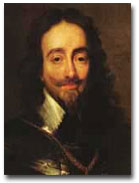 |
|
King
Charles I
|
In 1625, James I gave
up the throne, and his ghost. His son, distinguished in childhood by his
strong will, became Charles I. He kept frightfully busy using that strong
will of his: he mismanaged affairs (a chip off the ol' block), got into
a cantankerous battle with with Parliament, and brought on a civil war
that would result in his own execution. In his spare time, he was known
to like horses.
Charles pushed England
even a little further back towards Catholicism than his father had, chiefly
because he hated the Puritans even more. Parliament, now an even bigger
thorn in Charles' side than his father's, was summoned and dissolved three
times during 1625 - 1629. Parliament should have been summoned every year
or so in order to take care of the Kingdom's business. During the next
eleven years, no King of England would ever enjoy this kind of absolute
power again because Charles didn't bother to summon Parliament. Just as
well, since they weren't about to give the King anymore money. Fine by
Charles - he financed his reign by selling commercial monopolies (today,
we call them "franchises") and extracting ship money - a
fee demanded from towns for building naval warships (today, we call
that "extortion"). One such commercial monopoly was the
Massachusetts Bay Colony. You were wondering when we'd get
back to Massachusetts, right? Hold on, it's coming up soon.
To add gasoline to
the fires already burning, Charles married a devoutly Catholic French
princess that further angered the increasingly Puritan Parliament. Her
Catholic friends held sway at the royal court. She interfered in the affairs
of state, and put her wants above the needs of the Kingdom. And you thought
the Beatles had it rough.
Massachusetts, Inc.
 All
right, back to the Puritans. Things got worse for nonconformists under
Charles I. Sure, the Pilgrims got to leave in 1620, but what about the
poor Puritans, incensed by the tide turning evermore to the Catholic leanings
of the Church-State? As mentioned before, it was illegal to leave England
without the permission of the King, and that was fairly unlikely if for
no other reason than spite. However, fate finds a way - even if it's a
legal loophole. All
right, back to the Puritans. Things got worse for nonconformists under
Charles I. Sure, the Pilgrims got to leave in 1620, but what about the
poor Puritans, incensed by the tide turning evermore to the Catholic leanings
of the Church-State? As mentioned before, it was illegal to leave England
without the permission of the King, and that was fairly unlikely if for
no other reason than spite. However, fate finds a way - even if it's a
legal loophole.
 On
March 4th, 1629, the Massachusetts Bay Company was given its Charter
by Charles I. Although
it was a commercial company interested in cultivating trade in the new
colony, the leading promoters of it were Puritans intent on creating a
church free from outside interference. Apparently, they didn't write that
down on their application to the King. When King Charles granted a colonial
charter to the Massachusetts Bay Company, the document failed to specify
that the governor and officers of the company had to remain in England.
You can read it for yourself.
The Puritan stockholders took advantage of this omission, and moved the
whole company and its colonial government flock, stock, and barrel to
America. They would then establish a biblical community - "a holy
commonwealth" - as an example to England and the world. The Puritans
would finally get to leave England, under the nose of the King, all because
of a legal loophole. The Massachusetts Bay Company would ferry
thousands of Puritans to America over the next few years. On
March 4th, 1629, the Massachusetts Bay Company was given its Charter
by Charles I. Although
it was a commercial company interested in cultivating trade in the new
colony, the leading promoters of it were Puritans intent on creating a
church free from outside interference. Apparently, they didn't write that
down on their application to the King. When King Charles granted a colonial
charter to the Massachusetts Bay Company, the document failed to specify
that the governor and officers of the company had to remain in England.
You can read it for yourself.
The Puritan stockholders took advantage of this omission, and moved the
whole company and its colonial government flock, stock, and barrel to
America. They would then establish a biblical community - "a holy
commonwealth" - as an example to England and the world. The Puritans
would finally get to leave England, under the nose of the King, all because
of a legal loophole. The Massachusetts Bay Company would ferry
thousands of Puritans to America over the next few years.
On August 26th, 1629, a dozen shareholders from Boston, Lincolnshire,
including John Winthrop and Thomas
Dudley signed a contract to "inhabit and develop New England",
assuming of course they'd be allowed to govern the new colony themselves
from Massachusetts. Seemed reasonable. The first governor of the Company
was John Winthrop, Dudley was made his deputy, plus there were the usual
entourage of bureaucrats, assistants, etc.
Puritan society was
very understandably excited about the venture. Many licenses to migrate
were applied for and granted, obliviously without background checks. By
April 1630, Winthrop's great fleet of eleven vessels was ready to sail
from Southampton carrying the first Lincolnshire contingent aboard the
flagship Arbella. Apart from Winthrop himself, these included Thomas
Dudley and his family, Anne Bradstreet
and her husband Simon, and Lady
Arbella Johnson and her husband Isaac. Although ill, John Cotton traveled
to see them off, not passing up the opportunity to give a sermon for the
whole company.
The
Founding of Boston, Massachusetts
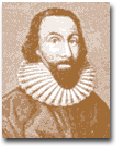 |
|
John
Winthrop
|
 By
mid-July of 1630, Winthrop’s fleet had reached the shores of Massachusetts,
but their first landing at Salem was a disappointment as the settlement
was short of food and not able to support another thousand inhabitants
(much like cars today). Though they found their way to the mouth of the
Charles River, their health had deteriorated so badly that at least 200
had died. Across the Charles River, William Blackstone, a former clergyman,
was living an isolated existence as a trapper on the Shawmut Peninsula
- the original land mass of Boston. Word came to him from Indian friends
of the difficulties his fellow countrymen were having. He sent a message
to John Winthrop advising him that the Trimountain hills on his side of
the river were far more suitable for settlement. By
mid-July of 1630, Winthrop’s fleet had reached the shores of Massachusetts,
but their first landing at Salem was a disappointment as the settlement
was short of food and not able to support another thousand inhabitants
(much like cars today). Though they found their way to the mouth of the
Charles River, their health had deteriorated so badly that at least 200
had died. Across the Charles River, William Blackstone, a former clergyman,
was living an isolated existence as a trapper on the Shawmut Peninsula
- the original land mass of Boston. Word came to him from Indian friends
of the difficulties his fellow countrymen were having. He sent a message
to John Winthrop advising him that the Trimountain hills on his side of
the river were far more suitable for settlement.
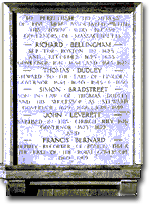 |
|
Memorial
stone in St.Botolph's Church dedicated to the five Boston men who
became Governors of Massachusetts
|
Winthrop, who had
been at college with Blackstone
(as unbelievable as that sounds), went to see him and it was this meeting
in 1630 that really marked the foundation of the city of Boston. Within
the next few weeks several small wooden houses were built by the migrants
and at the suggestion of Thomas Dudley it was decided that the new settlement
be called Boston after its English namesake. Remember, the Puritans did
not want a break with England, just to create an example of what could
be if England followed their example. Hence, they'd fashion their Boston
in their own image, so to speak. Over the next few years many more Lincolnshire
migrants arrived. Indeed, a memorial stone in St.Botolph's Church commemorates
the five Boston men who became Governors of Massachusetts, those being
Thomas Dudley, Richard Bellingham, Francis Bernard, John Leverett and
Simon Bradstreet.
So that's where, and
how, Boston, Massachusetts got its name. From Boston, to Boston.
You can think of the two Bostons as opposite ends of the same conduit
stretching from the religious and political upheavals of England to the
hope and promise of the New World. Not all legal loopholes have worked
out quite so well.
But what happened
to Charles? I was just getting interested...
Meanwhile, Back in
England...
 While
the Massachusetts Bay Colony began to thrive, Charles' problems went from
bad to worse. A problem back home in Scotland ended Charles' 11 years
of sole rule and brought about a civil war upon England. Charles had decided
that the Scots needed a new prayer book. "What's the harm in a new
prayer book? The Scots will love it." Instead, the Scots rebelled.
Due to the chronic lack of proper funding, Charles' army was no match
for the surprise resistance. The King called two Parliaments, one short,
one long, but they could reach no agreement. The Queen, of course, could
be counted on to have an opinion: why not begin arresting members of Parliament?
Charles went to the House of Commons - the first King to have ever done
so - and tried to arrest John Pym, the leader of Parliament and four of
his closest allies, but failed to do so as they had escaped the day before.
Embarrassed and in a snit, Charles ventured north to raise an army and
declared war against Parliamentary forces at Nottingham in 1642. While
the Massachusetts Bay Colony began to thrive, Charles' problems went from
bad to worse. A problem back home in Scotland ended Charles' 11 years
of sole rule and brought about a civil war upon England. Charles had decided
that the Scots needed a new prayer book. "What's the harm in a new
prayer book? The Scots will love it." Instead, the Scots rebelled.
Due to the chronic lack of proper funding, Charles' army was no match
for the surprise resistance. The King called two Parliaments, one short,
one long, but they could reach no agreement. The Queen, of course, could
be counted on to have an opinion: why not begin arresting members of Parliament?
Charles went to the House of Commons - the first King to have ever done
so - and tried to arrest John Pym, the leader of Parliament and four of
his closest allies, but failed to do so as they had escaped the day before.
Embarrassed and in a snit, Charles ventured north to raise an army and
declared war against Parliamentary forces at Nottingham in 1642.
Religious and economic
issues added to the differences between the supporters of the Monarchy
(Cavaliers) and the supporters of Parliament (Roundheads). Roughly speaking,
Cavalier backing came from peasants and nobility of Episcopalian roots,
while Roundhead backing came from the emerging middle-class and tradesmen
of the Puritanical movement. In terms of geography, the northern and western
counties aided the Cavaliers, with the more financially prosperous and
populous southern and eastern counties supported the Roundheads. Not unlike
the American Civil War, the Roundheads, with more money and more population
from which to draw, were destined to win the battle.
  In
1645, Oliver Cromwell and his New Model Army at Naseby easily defeated
the Cavaliers. A year later, Charles surrendered to Scottish forces, which
turned the King over to Parliament, along with a considerable amount of
unused prayer books I should think. In 1648, Charles was put on trial
for treason. A tribunal, by a vote of 68 to 67, found the King guilty
and ordered his execution in 1649. He was beheaded. In
1645, Oliver Cromwell and his New Model Army at Naseby easily defeated
the Cavaliers. A year later, Charles surrendered to Scottish forces, which
turned the King over to Parliament, along with a considerable amount of
unused prayer books I should think. In 1648, Charles was put on trial
for treason. A tribunal, by a vote of 68 to 67, found the King guilty
and ordered his execution in 1649. He was beheaded.
After that, Oliver
Cromwell dismantled government and many governmental institutions, in
an almost Soviet-style of takeover. The Puritans were now in power, and
the State swung 'round again towards Puritanism and reform. Crazy-Ivan
number four. After many failed attempts of governing, Cromwell finally
came up with the ultimate solution: he would become "Lord Protector
of the Realm," or in effect King. Upon his death, his son
Richard became the new Lord Protector of the Realm, and through his inability
to do a better job, the Monarchy was restored about a year later, giving
England the restoration of the House of Stuart with Charles II: The Sequel.
Parliament had severely
restricted the powers of the King, however, the people were happy that
they had a King again... as long as he behaved. Conflicts with the Dutch
caused Charles to form an alliance with France that supposed he would
reintroduce Catholicism back to England "at an appropriate time."
However, it never happened. No Crazy-Ivan this time, as Charles II did
nothing to steer the State anywhere in religious terms.
But that's all English
history. At that point, Massachusetts was a thriving colony, well on it's
way to forge it's name in history, with its Boston leading the way.

|
